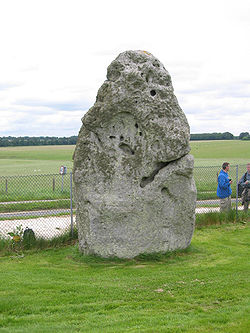
Heelstone
Encyclopedia

Sarsen
Sarsen stones are sandstone blocks found in quantity in the United Kingdom on Salisbury Plain, the Marlborough Downs, in Kent, and in smaller quantities in Berkshire, Essex, Oxfordshire, Dorset and Hampshire...
stone standing within the Avenue
Avenue (archaeology)
British Archaeologists refine the general archaeological use of avenue to denote a long, parallel-sided strip of land, measuring up to about 30m in width, open at either end and with edges marked by stone or timber alignments and/or a low earth bank and ditch...
outside the entrance of the Stonehenge
Stonehenge
Stonehenge is a prehistoric monument located in the English county of Wiltshire, about west of Amesbury and north of Salisbury. One of the most famous sites in the world, Stonehenge is composed of a circular setting of large standing stones set within earthworks...
earthwork, close to the main road (Highways Agency
Highways Agency
The Highways Agency is an executive agency, part of the Department for Transport in England. It has responsibility for managing the core road network in England...
A344). In section it is sub-rectangular, with a minimum thickness of 8 ft (2.4m), rising to a tapered top about 16 ft (4.7m) high. Excavation has shown that a further 4 ft (1.2m) is buried in the ground.
It is 254 ft (77.4m) from the center of Stonehenge circle. It leans towards the Southwest (pictured view) nearly 27 degrees from the vertical
Vertical direction
In astronomy, geography, geometry and related sciences and contexts, a direction passing by a given point is said to be vertical if it is locally aligned with the gradient of the gravity field, i.e., with the direction of the gravitational force at that point...
. The stone has an overall girth
Girth
In graph theory, the girth of a graph is the length of a shortest cycle contained in the graph. If the graph does not contain any cycles , its girth is defined to be infinity....
of 25 ft (7.6m) and weighs about 35 tons.
Myths
Mythology
The term mythology can refer either to the study of myths, or to a body or collection of myths. As examples, comparative mythology is the study of connections between myths from different cultures, whereas Greek mythology is the body of myths from ancient Greece...
and legends of the Devil
Devil
The Devil is believed in many religions and cultures to be a powerful, supernatural entity that is the personification of evil and the enemy of God and humankind. The nature of the role varies greatly...
striking a "Friar's Heel" with a stone resulted in its eccentric name, Heel Stone. Some claim "Friar's Heel" is a corruption of "Freyja's He-ol" or "Freyja Sul", from the Nordic goddess Freyja and (allegedly) the Welsh
Wales
Wales is a country that is part of the United Kingdom and the island of Great Britain, bordered by England to its east and the Atlantic Ocean and Irish Sea to its west. It has a population of three million, and a total area of 20,779 km²...
words for "way" and "Sunday" respectively. It is doubtful whether any prehistoric
Prehistory
Prehistory is the span of time before recorded history. Prehistory can refer to the period of human existence before the availability of those written records with which recorded history begins. More broadly, it refers to all the time preceding human existence and the invention of writing...
standing stone has experienced as many name changes and interpretations. Only in the past three decades have world scientist
Scientist
A scientist in a broad sense is one engaging in a systematic activity to acquire knowledge. In a more restricted sense, a scientist is an individual who uses the scientific method. The person may be an expert in one or more areas of science. This article focuses on the more restricted use of the word...
s used the name Heelstone consistently.
Source
- AtkinsonRichard J. C. AtkinsonRichard John Copland Atkinson CBE was a British prehistorian and archaeologist.-Biography:He was born in Evershot, Dorset and went to Sherborne School and then Magdalen College, Oxford, reading PPE...
, R J C, Stonehenge (Penguin Books, 1956) - Cleal, Walker, & Montague, Stonehenge in its Landscape (London, English Heritage 1995)
- Cunliffe, B, & Renfrew, C, Science and Stonehenge (The British Academy 92, Oxford University Press 1997)
- Hawley, Lt-Col WWilliam HawleyLieutenant-Colonel William Hawley was a British archaeologist who most famously undertook pioneering excavations at Stonehenge....
, Report on the Excavations at Stonehenge during the season of 1923 (The Antiquaries Journal 5, Oxford University Press, 1925)
Further reading
- Newall, R S, Stonehenge, Wiltshire (Ancient monuments and historic buildings) (Her Majesty's Stationery Office, London, 1959)
- Pitts, M, Hengeworld (Arrow, London, 2001)
- Pitts, M W, On the Road to Stonehenge: Report on Investigations beside the A344 in 1968, 1979 and 1980 (Proceedings of the Prehistoric Society 48, 1982)
- Stone, J F SJ. F. S. StoneJohn Frederick Smerdon Stone was a British archaeologist, most famous for his work in and around Wiltshire, especially at Stonehenge and the Woodhenge area....
, Wessex Before the Celts (Frederick A Praeger Publishers, 1958)

